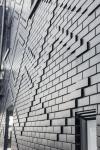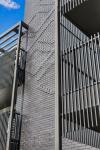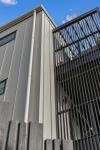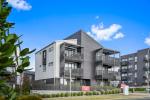Te Uru Terraces

Typical of Hobsonville Point, Te Uru Precinct features a range of architectural styles but what makes Te Uru Terraces different is the way their design drew on Maori influences to give them a sense of place.
The inspiration behind the design of the townhouses and the way they make high-density living appealing produced a winning combination in the 2023 National Resene Architectural Design Awards, with the development jointly taking home the prestigious Supreme Award.
The judges of the awards said Te Uru Terraces provided the perfect example to Tamaki Makaurau / Auckland of how to build high density, liveable housing.
The judges said that the eight separate buildings provide a number of townhouses, with a common language of forms being individualised by colour, materials and textures into homes for all.
“The cultural history of the site is written into the façade in places, with careful weaving of patterns into the brickwork referencing the welcoming action that the buildings do, as both a karanga and a hongi to the incoming visitors.”
With input from Ngati Whatua o Kaipara and designed by Construkt Architects in conjunction with the Fletcher Living team, the terraces’ unique design impressed the judges, who said they were an example of “density done well”.
While the buildings present as traditional three-storey terrace homes, the first floor of the buildings contains a one-bedroom unit, with the upper two levels being a spacious three-bedroom home. Both dwellings enjoy their own private entrances and private outdoor spaces. This design combines terrace and apartment living to great effect, creating increased density and a variety of home sizes.
The provision of the one-bedroom units was a key part of the design brief, helping to meet the affordability target required by Kainga Ora in Hobsonville Point.
The design of the terraces is contemporary and varied, comprising a mix of materials and forms that create a vibrant streetscape but one that is also in keeping with the context of the surrounding developments.
Part of that mix of materials is the roofing, in Trimrib ColorCote® MagnaFlow™ in ‘Titania’ and ‘Ironsand’, with the contrasting colours helping to delineate the homes.
Kyle Golder, of roofing installer Aspect Roofing, said it was an exciting project to be involved with as it had “good designs visually and nice large roofs for the team to get stuck into once we got over the challengers at the beginning”.
He said, “The main challenge was the height of the building, which required a large crane to lift the roofing materials. There were also three skylights in a row up on the roof which where a challenge to flash – this was a fun challenge for the team. The staged nature of the job meant we installed the lower roofs first then the scaffolding was built on top of the lower roofs.”
The development is bookended by two marker buildings, creating strong visual anchors on either end that also emphasise the street corners and show off the value of a cohesive urban block.
Award winning architect Madushin Amarasekera, of Construkt Architects, credits the input of Ngati Whatua o Kaipara for many of the creative design elements that make the buildings so special.
“Incorporating te ao Maori design elements into the building fabric in a subtle, sophisticated manner was always the intention.”
Madushin commended the work of Mei Hill as the Ngati Whatua o Kaipara conduit for the culture design aspects. “We worked closely with her when it came to integrating her patterns onto the building facades.”
He added, “Engagement with Ngati Whatua o Kaipara was fundamental in establishing pertinent architectural responses, through understanding what mana whenua wanted for the site and its context.
“Once we received a narrative from them, we worked on our own architectural response."
“We feel it was fitting that the final concept drew inspiration from the Powhiri, the traditional Maori welcome, with the development symbolically welcoming visitors to Hobsonville Point.”
Two important parts of the Powhiri are the Karanga and ‘Hongi’; the former is the fourth stage of the Powhiri, a spiritual call through the passages of time from women to women. Its purpose is to weave a spiritual rope to allow the waka of the manuwhiri to be pulled on; it should be continuous, weaving in and out of each other. The continuous spiritual call is abstracted into the undulating, repeating roof form pattern – a visual echo to the melody of the Karanga. The ‘Hongi’ is the mixing of the Maori of both the Tangata Whenua and the Manuhiri, it is the first physical contact – each building’s roof forms reach out to meet, symbolically representing the traditional greeting.
Urban Design Team Leader Orson Waldock at Kainga Ora and convener of the Hobsonville Point Urban Design Review Panel was involved with the terraces project early on.
He said, “More commonly referred to as a maisonette, this typology has been through several design iterations at Hobsonville Point. These innovative buildings have become an increasingly important way to deliver greater density within an approachable and recognisable three-level built form.
“This typology gives us the ability to deliver a larger number of smaller, more affordable and more accessible ground floor units at Hobsonville Point. This increase in housing choice provides options for those with mobility needs as well as the opportunities for multi-generational living within a single walk-up terrace”.
“Based on the success of Te Uru, we are now exploring how this type of housing could be used to support public housing, to help us achieve our mandate of delivering more homes for all New Zealanders.”






